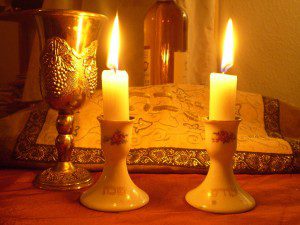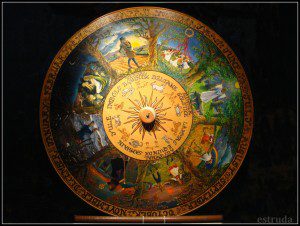In the Wiccan tradition in which I was trained, as in many others, we practice with deep attention to time. Our ceremonies are based on the demands of the season, the needs of the community, and of course, the whim of the ritualists. We write, share, build ceremony, and meditate on the various states each six-week section the solar calendar invites. Time is holy.
Many of us move through the Labyrinth, that time out of time. Time small, the time we take to trace the labyrinth’s curves, and time great, a lifetime of in and out, back and forth, lessons taught and lessons learned. Time is holy.
Some of us celebrate the esbats, or full moons, and some celebrate both full and new moons. Some follow astrological forms and methods and organize our practice around the spheres’ celestial music. At any time at any places, we may be invited into magic, ritual, song, or simply deep attention to the holiness of a given moment. Time is holy.
Other traditions share the experience of holy time. While they may have greater emphasis on holy space than many Pagans do, even UU’s—cathedrals, synagogues, temples—time is holy too.
In the Roman Catholic tradition in which I was brought up, we had a liturgical calendar. Various colors for different seasons. Various states of mind. Various prayers. Various music. Various shades and contours to the Mass. Time is holy.
Pema Chodron, a powerfully accessible Buddhist teacher, writes about the Pause, perhaps the smallest unit of time we make holy with attention. Just once, or multiple times a day, one may inhabit a pause, a breath, a moment out of the rest of work, play, relaxation. Time, all time, any time, is holy.
There is another tradition that carries a particularly powerful sense of the holiness of time, and that is Judaism. In Judaism, the very first thing Adonai calls holy, or “qadosh,” is the Sabbath, commonly referred to as the Day of Rest. The Day of shalom—peace, yes, but also delight and wellbeing.
 Shabbat in Hebrew, Shabbos in Yiddish, is not merely a day to abstain from work. It is a day of rest and delight. Of family and sexuality. Of beauty and tradition. (I must also point out here that in traditional Jewish families there entails a lot of work for women on the day before Shabbat— preparing food for the next day, preparing the house, etc. This additional work, holy as it is, should not be overlooked.)
Shabbat in Hebrew, Shabbos in Yiddish, is not merely a day to abstain from work. It is a day of rest and delight. Of family and sexuality. Of beauty and tradition. (I must also point out here that in traditional Jewish families there entails a lot of work for women on the day before Shabbat— preparing food for the next day, preparing the house, etc. This additional work, holy as it is, should not be overlooked.)
I do not suggest that non-Jewish UUs, much less those who root ourselves in the Sixth Source, take up the Jewish traditions of Shabbat wholesale. For one thing, most of us lack the depth of understanding and experience to do so well and faithfully. Furthermore, and more deeply, we do enough appropriating as it is.
I do, however, think it is wholesome to create a weekly practice, perhaps around the dinner table, that nurtures our sense of holy time. This weekly time around a meal is more accessible than regular ceremony under the changing moon. I have been separated for two years now from the Stone Circle where I joined others and celebrated those tw’eekly liturgies. I need a reminder that the season, not just the year, is turning by smaller increments than the Eight Holidays. I need a reminder that my work and the life of my family are sacred. This holy time, a time of mirth and reverence, can be the Pause, writ large, the Wheel, writ small.
So what might it be, this attention to holy time?
What grounds you in your particular tradition or practice?
In my life, the altar is the spatial center of my solitary meditations. Song and conscious breathing at my altar are the temporal centers. So for me, part of weekly holy time is dusting and perhaps organizing my altar a bit. Perhaps attending to the candles on a seasonal altar. Perhaps tending the plants in my holy space. Reverent attention. Solitary, reverent attention.
But what about mirth? What about the delight half of the rest and delight/mirth and reverence duo?
That’s where dinner comes in, especially—but not exclusively—if we have children. There may be family favorites, special candles or plates, a special tablecloth. All kinds of things that can bring kids into the experience. Plates they’ve painted and napkins they’ve embroidered depending on their ages. Singing. Hand gestures and games. Blessings. Appreciation of one another and of the food and the plants, animals, people, and systems that have brought it to us. Reminders of the solar season we inhabit or the phase of the moon we are in. There are nearly infinite ways to make a weekly dinner as simple or as festively complex as we’d like.
In my house, honestly, it comes and goes.
We do have special candles. We do have special china. There are foods we may eat for the day, and those foods change for the season. But it comes and goes. I know few people whose observances are perfect, whatever that word might mean for us; we do not have Holy Days of Obligation, after all!
Still, time is holy.
Time is holy, and this is the time we have been given, the time we have, spend, kill, or inhabit.
May we find time to remind ourselves of the sacredness of life, of the holiness of work and of rest, of mirth and of reverence, all bound together in the tapestry of time. So may it be.
Images acquired through Creative Commons.

















